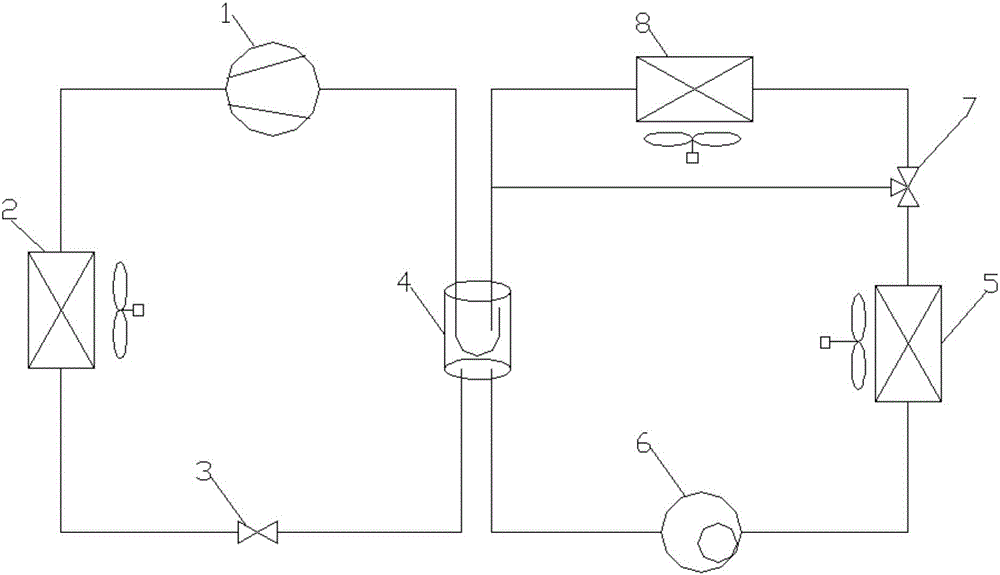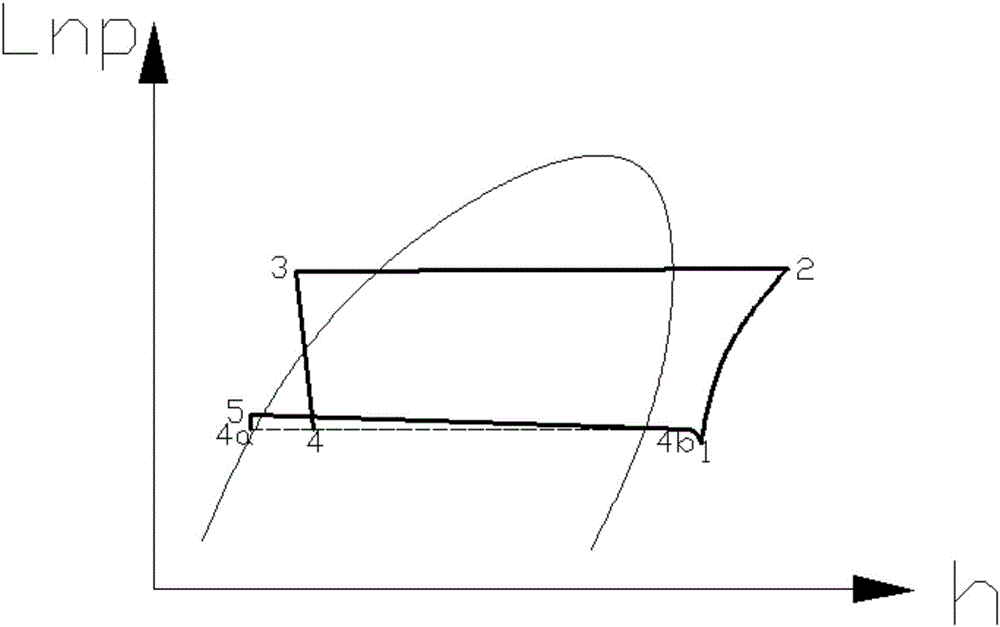Combined air conditioning system for machine room and control method thereof
A computer room air conditioner and composite technology, which is applied in the direction of refrigerators, compressors, refrigeration components, etc., can solve the problem of unfavorable use of outdoor low-temperature air at the upper limit temperature, and achieve the effect of avoiding low heat transfer efficiency, small transmission work, and compact structure
- Summary
- Abstract
- Description
- Claims
- Application Information
AI Technical Summary
Problems solved by technology
Method used
Image
Examples
Embodiment 1
[0071] In summer, when the outdoor ambient temperature T is 33°C, which is greater than the preset temperature Tb, it is 25°C. At this time, it is determined that the operation mode of the air conditioning unit is the refrigeration cycle, and the temperature control device controls the three-way valve 7 to switch to the refrigeration cycle. Unit 1 is turned on and the heat exchange fan runs at full speed. The flow path of the refrigerant in a composite computer room air conditioning system is: from compressor 1 to refrigeration condenser 2, to throttling device 3 and low pressure accumulator 4. Then from the low-pressure accumulator 4 to the compressor 1 and refrigerant pump 6, the refrigerant from the refrigerant pump 6 to the evaporator 5, and then through the three-way valve 7, the low-pressure accumulator 4 and the refrigerant pump 6 in sequence; The outdoor environment temperature T is high, which makes the heat load of a composite computer room air-conditioning system larg...
Embodiment 2
[0083] When in spring or autumn, when the outdoor ambient temperature T is 22°C, lower than the preset temperature Tb is 25°C, and higher than the set temperature Ta is 15°C, the operation mode of the air conditioning unit is determined to be a combined cycle. , The temperature control device controls the three-way valve 7 to switch to the combined cycle. At this time, the compressor 1 is turned on and the heat exchange fan runs at full speed. The refrigerant flow path in a compound computer room air conditioning system is: from compressor 1 to refrigeration Condenser 2, then throttling device 3 and low-pressure accumulator 4, and then from low-pressure accumulator 4 to compressor 1 and refrigerant pump 6, and then the refrigerant from refrigerant pump 6 to evaporator 5, and then through Three-way valve 7, heat pipe condenser 8, low-pressure accumulator 4 and refrigerant pump 6; because the outdoor environment temperature T is low, the temperature control device controls a compo...
Embodiment 3
[0096] In winter, when the outdoor ambient temperature T is 8°C and the set temperature Ta is 15°C, the air conditioning unit operation mode is determined to be the heat pipe cycle, and the temperature control device controls the three-way valve 7 to switch to the heat pipe cycle. At this time, the compressor 1 is turned off, and the heat exchange fan runs at full speed or speed regulation. The flow path of the refrigerant in a composite computer room air-conditioning system is: from the refrigerant pump 6 to the evaporator 5, and then through the three-way Valve 7, heat pipe condenser 8, low pressure accumulator 4 and refrigerant pump 6; since the outdoor ambient temperature T is much lower than the temperature of the machine room, and sufficient cooling capacity can be provided to the machine room to maintain a suitable temperature in the machine room, Among the three control methods, the gaseous or gas-liquid mixed refrigerant flowing out of the indoor evaporator 5 exchanges ...
PUM
 Login to View More
Login to View More Abstract
Description
Claims
Application Information
 Login to View More
Login to View More - R&D
- Intellectual Property
- Life Sciences
- Materials
- Tech Scout
- Unparalleled Data Quality
- Higher Quality Content
- 60% Fewer Hallucinations
Browse by: Latest US Patents, China's latest patents, Technical Efficacy Thesaurus, Application Domain, Technology Topic, Popular Technical Reports.
© 2025 PatSnap. All rights reserved.Legal|Privacy policy|Modern Slavery Act Transparency Statement|Sitemap|About US| Contact US: help@patsnap.com



